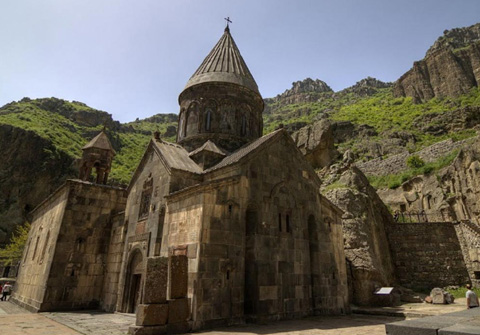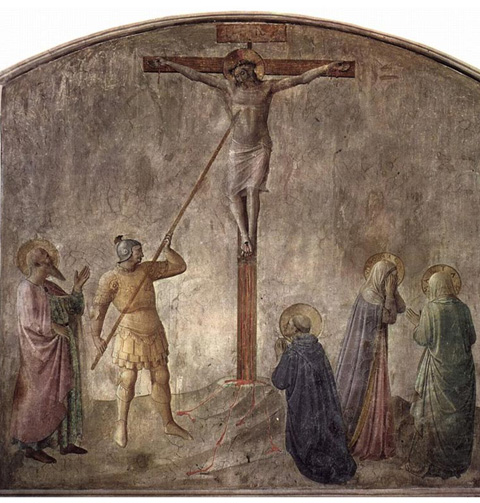Geghard Monastery: Ancient Guardian of the Lance that Stabbed Jesus?
- (0)
Geghard Monastery: Ancient Guardian of the Lance that Stabbed Jesus? –

Ancient Origins – According to the Gospel of John, Jesus was stabbed in his side by a lance whilst hanging from the cross. As a result, this weapon is believed to possess supernatural powers, and became an important and much sought after Christian relic. Over the centuries, a number of churches have claimed to possess this sacred object. One such claimant is the Geghard Monastery, or Geghardavank (meaning ‘Monastery of the Spear’).
The Geghard Monastery is located in Kotayk, a province in the center of Armenia. Situated at the head of the Azat Valley, the monastery is surrounded by towering cliffs. In fact, part of the monastery is carved out of the adjacent mountain. According to tradition, the Geghard Monastery was founded in the 4th century AD by St. Gregory the Illuminator. The site where St. Gregory chose to build the monastery was a spring arising in a cave that was regarded as sacred prior to the arrival of Christianity. Thus, the Geghard Monastery was known in earlier times as Ayvirank (meaning ‘Monastery of the Cave’)
Nothing remains of this first monastery, as it was destroyed in the 9th century AD by the Arabs. At the end of Muslim rule in Armenia, however, the monastery was re-established. The most ancient part of the present monastery is the Chapel of St. Gregory the Illuminator. The earliest inscription on its external wall has been dated to 1177 AD. This small chapel is located to the east of and outside of the main monastery complex. Carved directly into the rock of the mountainside, this project was abandoned before it was completed. By the first half 13th century, another building project was underway, thanks to the patronage of the brothers Zakare and Ivane, who were generals of the Georgian queen, Tamar.
Under the two generals, the Kathoghikè (the main church) was built. According to an inscription, this church was built in 1215 prior to 1250, the first cave church was also built.

The lance currently in Echmiadzin, Armenia. It was discovered during the First Crusade in St. Peter’s Cathedral in Antioch. Photo by Emanuele Iannone – Museum of Echmiadzin, Armenia. 2009.
Not long after, the monastery was bought by the princes of the Proshyan dynasty. Under the patronage of this Armenian noble family, the monastery was further developed. Over a short period of time, a second cave church, a hall for gathering and studies, as well as numerous monastic cells were also built. Furthermore, the family sepulchre of the Proshyan dynasty can also be found in the monastery. This is indicated by their coat of arms – two chained lions, between which is an eagle with half-spread wings, whose claws grasp a calf, carved in the rock.
It was also during the 13th century that the monastery gained its present name. When the monastery was re-established, it was first given the name ‘Monastery of the Seven Churches’. It was also known as the ‘Monastery of the Forty Altars’. In time, however, the name of the monastery was changed to Geghard Monastery. This was due to a legend, which claimed that the lance that pierced the side of Jesus was brought to Armenia by the St. Jude the Apostle, known also as Thaddeus, and was stored in the monastery.
In addition to this lance, the monastery was said to have housed a number of other Christian relics, including relics of the Apostles Andrew and John. It was these relics, the Holy Lance above all, which drew pilgrims to the Geghard Monastery. In the following centuries, numerous grants of land, money, manuscripts and other valuables were donate to the monastery. For instance, on the internal walls of the Kathoghikè, there are many inscriptions recording the donations made by pilgrims.
As of today, the Holy Spear can no longer be seen in the Geghard Monastery, as it is now resides in the museum of the Echmiadzin Monastery in the spiritual capital of the country. It is held in a special case of gilded silver made in 1687. Nevertheless, Geghard Monastery is still a popular tourist destination for local and foreign visitors alike. The site was even inscribed as a World Heritage Site in 2000, a testament to its importance in the history of Armenia and the world.

Fresco by Fra Angelico, Dominican monastery at San Marco, Florence, showing the lance piercing the side of Jesus on the cross (c. 1440)


















